"Excuse me, where is the Trafalgar Square?" Who among us hasn't learned this phrase in English class?
- one of the most famous symbols of London, along with Big Ben, Buckingham Palace and the British Museum. This is one of the most visited places in London, where most of the UK holidays are held.
It is noteworthy that - the geographical center of London - "zero kilometer", and from here the countdown of the mileage of all roads begins.
Also at Christmas, the main Christmas tree of the country is set up here, which is sent annually by Norway in gratitude for its liberation during the Second World War.
Was built in 1820 year on the site of the royal stables, and quickly took the place of the main square of London. When Edward I decided to dismantle the stables of the Whitehall Palace, the architect John Nash proposed to create a spacious square on the site of the resulting wasteland. The project was approved and construction began.
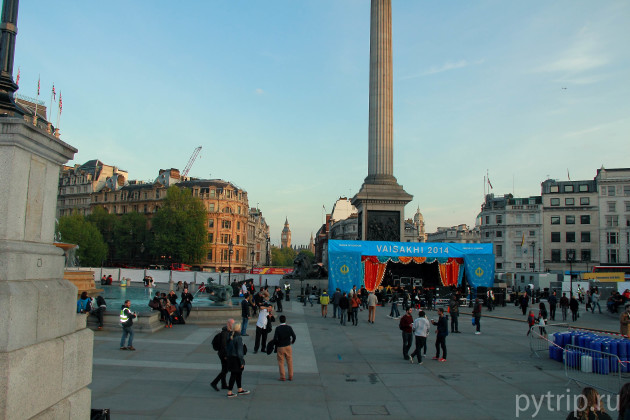
Trafalgar Square, some kind of performance is being prepared.
The square was originally named after King William IV, but in 1830 it was renamed in honor of the victory of the English fleet in 1805 at the Battle of Cape Trafalgar.
In the UK, many exhibitions and sections in museums are dedicated to this event, but it is this victory that glorifies this victory most of all. In this battle, Admiral Horatio Nelson, the commander of the British fleet, died, and the column created and installed in the middle of the square in his honor became its symbol.
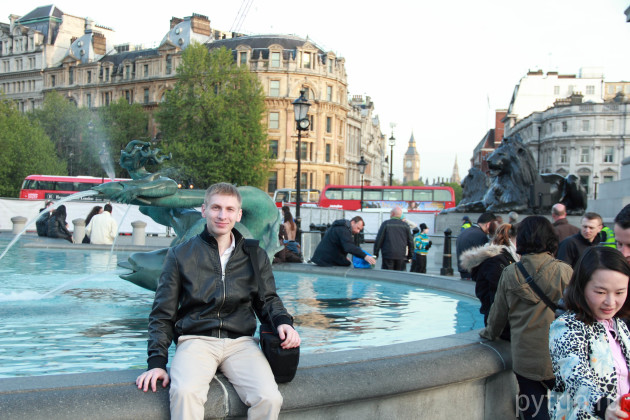
At the fountain. Away - Big Ben
Admiral Nelson is buried in St. Paul's Cathedral.
The architect Charles Berry completed the project of Trafalgar Square, John Nash did not live to see the completion of his new grandiose project.
What can be seen on the square
Nelson's Column
In the very center of the square Nelson's Column built in 1842. This is a 44-meter granite monument, on top of which there is a five-meter statue of Admiral Nelson. On four sides, the column is decorated with bronze frescoes cast from melted down Napoleonic cannons.

Lions are the immortal guardians of Nelson's Column.
They depict the famous battles of Admiral Nelson: the battle of St. Vinser in 1797, at Cape Aboukir in 1798, at Copenhagen in 1801, and, of course, at Trafalgar in 1805.
The column is surrounded by four "guards" of Nelson - six-meter sculptures of lions, installed a quarter of a century after the creation of the column. They symbolize the victories of the British fleet under the command of Admiral Nelson.
Monument to Charles I
This bronze monument is located in the south of the square and depicts Charles I on horseback. This is the first equestrian sculpture in England, created in 1630 by the sculptor Hubert Le Sueur. Every year on the day of the execution of the king - January 30 - flowers are laid at the monument.

Previously, Charing Cross was located on this site (the nearest metro station to Trafalgar Square is named after him), installed in honor of the wife of Edward I.
A little later, this place acquired the sad fame of the place of execution of regicides. After the monument to Charles I was erected, a pillory was placed next to it.

Four pedestals and monuments
At the four corners square - four pedestals. On three of them, "stationary" monuments have long been installed - to King George IV, General Charles Napier and General Henry Havelock. These personalities were chosen by the townspeople themselves. And here's the fourth one...

Fourth pedestal
Initially, they wanted to erect a monument to William IV on it, but there were not enough funds. And until 1999, the fourth pedestal was empty, and then temporary works of contemporary art began to be exhibited on it, attracting tourists and Londoners with their originality.
The first work exhibited on the fourth pedestal was a sculpture Mark Wallinger "Ecce Homo". Then came the composition Bill Woodrow - Disrespect for History in 2000 and "Monument" by Rachel Whiteread in 2001. And again there was a lull, which lasted until 2005.
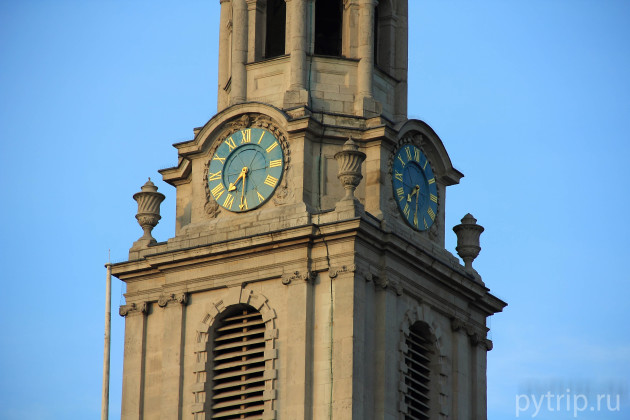
In September 2005, a sculpture was installed on this pedestal Mark Quinn "Disabled Pregnant Woman Alison Lepper", two years later it was replaced by the installation Thomas Schütte "Hotel Model".
In 2009 the sculptor Anthony Gormley proposed a very unusual project called "One and the other": from early July to mid-October, any Briton could try himself as a "living sculpture". "Sculptures" replaced each other every hour, and a total of 2,400 Britons took part in it.
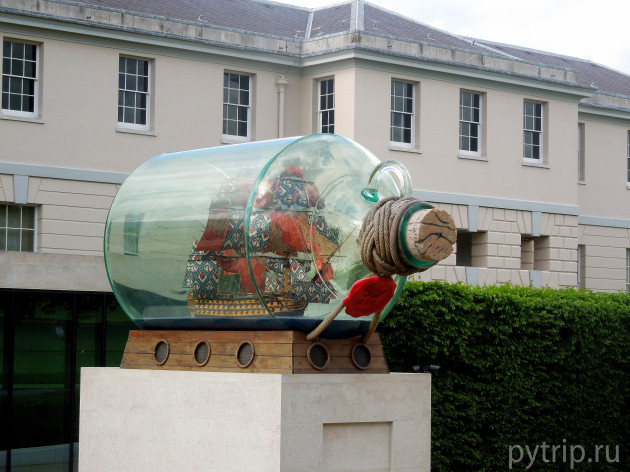
This is not the ship that was exhibited, but also depicts the Victoria. Monument from Greenwich.
In 2010, on the pedestal was installed model of Nelson's ship "Victoria"(now in the Portsmouth Historic Dockyard Museum) and was replaced in 2012 by bronze statue of a boy on a toy horse.
In 2013, the fourth pedestal was occupied by the most scandalous and extraordinary sculpture, which stands out from the architecture of the square - Blue Rooster Monument.
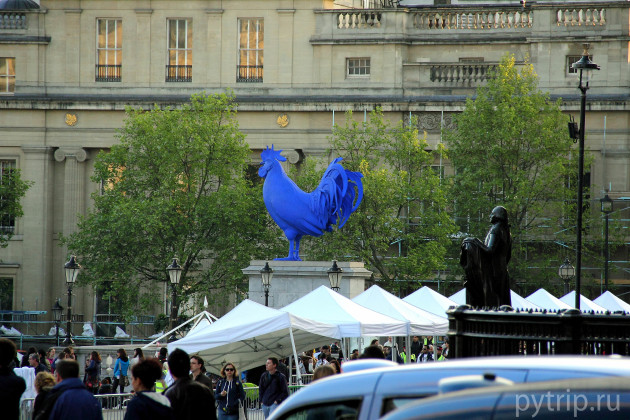
That Blue Rooster in Trafalgar Square
The author of this sculpture Katharina Fritsch. She claims that the blue Rooster symbolizes strength and renewal.
Attractions around Trafalgar Square
Around trafalgar square many interesting places. From the north - - the main art gallery of England, and a little further - the National Portrait Gallery.

In the northeast of the square - Church of St. Martin in the Fields(St Martin-in-the-Fields).
And on the way to Buckingham Palace, it's impossible not to notice Arch of the Admiralty.
Pigeons in Trafalgar Square
One of the biggest problems for any piece of architecture is pigeons. These voracious and shitting parasites everywhere can create a lot of problems.
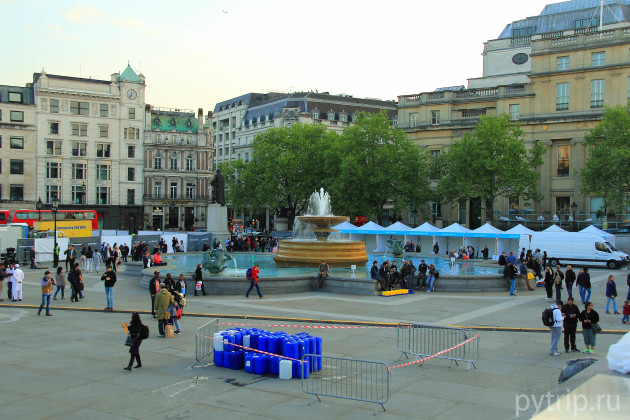
Birds were fed by numerous tourists and residents of London, and their number grew every day. There were even bags of food for sale on the square. The administration of London spent hundreds of thousands of pounds to clean the monuments from their droppings, and when the number of pigeons reached 35,000 individuals, patience ran out.
First, in 2000, they banned the sale of food, but this did not bring any effect. Then, on September 10, 2007, it was forbidden to feed pigeons in the square. It worked, and now trafalgar square there are practically none.
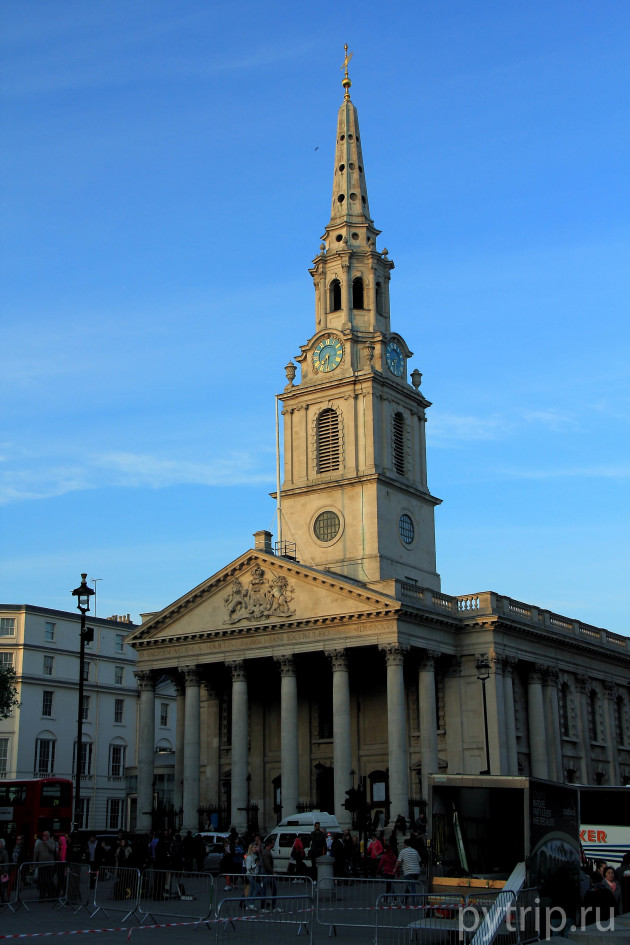
The square hosts various events and concerts. When we were there on the weekend, we set up some kind of tents and tents ...
